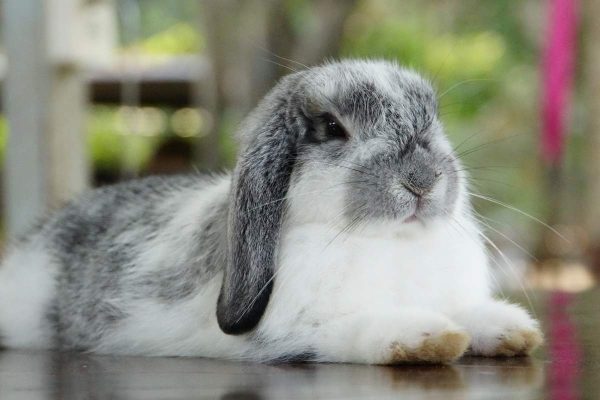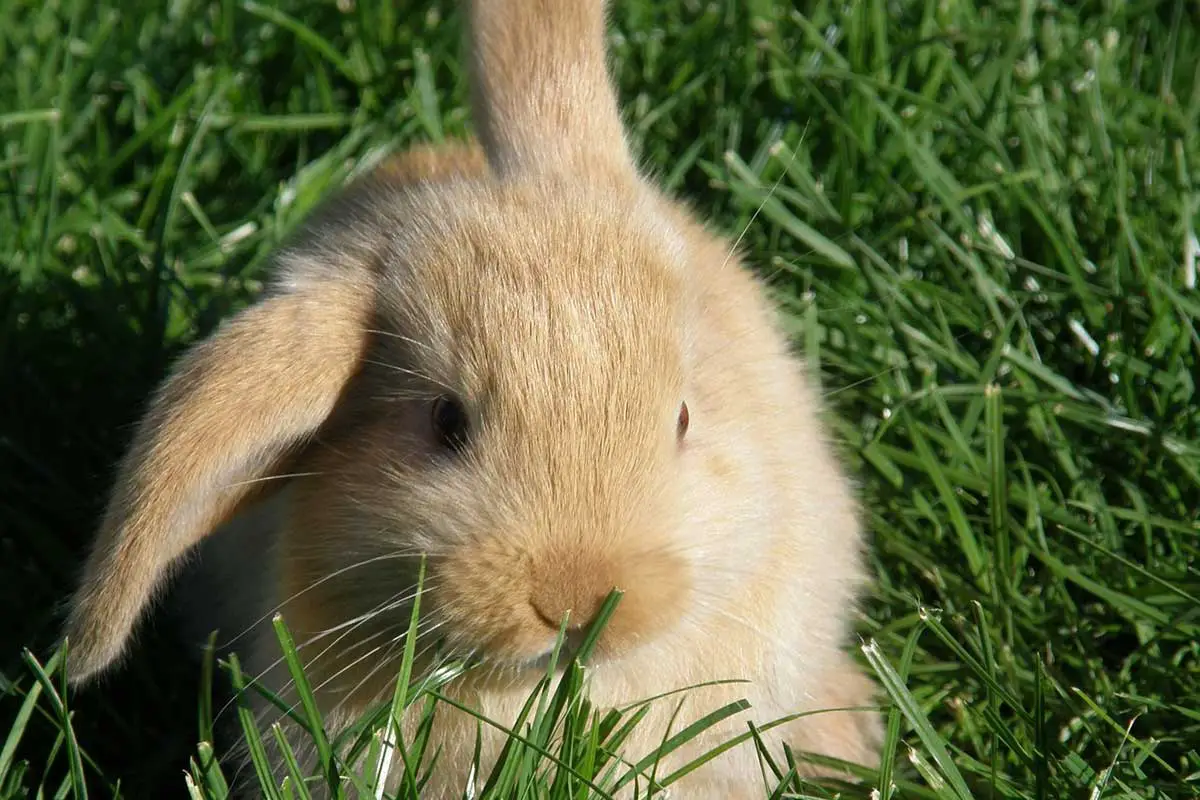For those fortunate enough to have a rabbit in their homes, the quirks and antics of our furry friends usually come as no surprise. However, every once in a while, something still may catch us off guard—like a single floppy ear. Chances are this is nothing to worry about, but it never hurts to take the time to be sure.
So, why does my rabbit have one ear up and one down? The most likely reason, depending on its breed and overall health, is that your rabbit is expressing one of the countless moods or emotions of which our rabbit companions are capable.
In this article we will examine your rabbit’s body language and the many purposes for which it uses those big ears, how breed can affect a rabbit’s ear position, and some possible illnesses or injuries which could be causing this behavior.
Why Do Bunny Ears Flop?
The flopping of bunny ears is typically a sign of contentment and relaxation. When a bunny feels safe and comfortable, its ears may gently flop to the side or even backward. Bunny ear positions, including flopping, are part of their intricate communication system.
Erect ears can indicate alertness or excitement, while flattened ears might signal fear or submission. Understanding these various bunny ear positions, along with other body language cues, allows rabbit caregivers to decipher their furry companions’ emotions and reactions more accurately.
Bunny Body Language

A rabbit’s ears are amongst its most important sensory tools, and both wild and domestic rabbits use their ears for endless purposes. Ears are part of the sharp sensory system that allows rabbits to maintain vigilance in the wild, protecting them from predators.
They are also a key part of how rabbits communicate their feelings. They even help our furry friends regulate their body temperature in both heat and cold! The connection between a rabbit’s keen sense of hearing and how it is communicating is key.
Relaxed rabbits who feel safe have different body language signals than rabbits who are fearful or think they sense danger. Therefore, as their human companions, it is particularly important that we understand bunny body language.
If your erect-eared, or “uppy-eared,” breed rabbit is healthy but occasionally droops one ear, body language is likely driving this behavior. A few common erect-eared breeds include the Rex, Flemish Giants, Lionheads, Dutch rabbits, dwarf varieties, and the Himalayan. Understanding your rabbit’s breed can also help with understanding this behavior, which we will cover later.
As we already discussed, rabbits use their ears to communicate how they are feeling or to interpret their environment. The bunny’s ear position can convey meaning if their human companion knows what to look for.
For example, if your rabbit’s ears are erect, meaning pointed upwards, with the insides of the ears pointed out and away from their body, they are happy and relaxed, especially if this ear position is coupled with a relaxed body posture.
Conversely, if your rabbit’s ears are alert and twitching around, it is probably trying to locate the source of an interesting, or what it perceives as a potentially dangerous, sound. Because of their sharp senses and inherited instincts, rabbits are always listening for new and interesting sounds.
Sometimes, however, a sound may not warrant their full attention. This could be where having one ear up and one down, known as the “half-lop” position, can come in. If your rabbit is picking up on a noise that is somewhat interesting, it may be “half-listening,” and trying to determine if the sound is worth its time.
Your rabbit also expresses emotions like fear, frustration, and anger with its ears. These emotions are usually expressed with ears pushed backward, sometimes wide apart and flat against the back as with fear, while other times they may remain together and slightly upward but facing back, as with anger or frustration.
At times, your rabbit might be demonstrating a “half-lop” ear position as it transitions from one emotion to another. This may mean your rabbit is vaguely on its way to frustration or anger, but because of the soft body language this mood swing can likely be headed off with some grooming or a treat.
If your rabbit does not seem to be exhibiting this behavior as a way of expressing its emotions, or if the floppy ear suddenly showed up one day and has not gone away, your “uppy-eared” rabbit might have some lop genes.
Breed

Lop-eared rabbit breeds have long, floppy ears that usually begin to droop between 4 and 12 weeks of age but can sometimes take longer. If your bunny is still a baby, you might have a lop breed or lop mix. Breeds like this include the English, French, and Holland Lops, Miniature Lops, German Lops, and Dwarf Lops.
The reason lops have floppy ears is due to the way their “crown,” or the band of cartilage that spans the top of the skull, is formed. A lop rabbit’s ear muscles lack the control their erect-eared cousins have at the point where they attach to the crown, resulting in adorable floppy ears.
This endearing trait was selectively bred through various domestic rabbit lines, so its origins are unclear. Because of this, the lop-eared gene does not follow the typical dominant vs. recessive rule that many other genes follow, resulting in what is sometimes called “helicopter ears.”
Most lop breeds end up with two adorably floppy ears that skim the ground on either side as they frolic. A select few, however, end up with the half-lop or “helicopter” variation of one perky ear and one floppy. Further still, others end up with ears that stick straight out to the side or stand up in a loose “V” shape.
There are quite a few ear variations with which a lop rabbit can end up, and because of the relative unpredictability of the gene, it can present itself in mixed-breed rabbits that otherwise present as erect-eared.
So, if your young, previously “uppy-eared” companion recently began exhibiting this trait and is otherwise happy and healthy, they might just have a little bit of lop thrown into their genetic mix.
If you are positive of your pet’s breed and have ruled out any body language cues, the “half-lop” position may mean there is something wrong.
Illness
There are a variety of illnesses that can strike our furry friends despite our best efforts to prevent it. Sometimes, as mentioned above, a rabbit’s ears can help tell us how they are feeling, including when they are feeling under the weather.
Ear drop, either in both ears or just one, can be a sign of an ear infection or other illness in rabbits. Otitis is a common ear infection that has several possible causes including bacterial and fungal infections, parasites, allergies, or the presence of foreign bodies.
If you suspect an ear infection, check your friend’s ears for redness, inflammation, discharge, or strong odors, and give your veterinarian a call. This type of infection is typically easily treated to get your perky-eared bunny back to its old self quickly.
Some other less common causes of ear drop can be ringworm, or a viral infection known as shope papilloma virus. Contrary to popular belief, ringworm is not actually a worm, but a fungal disease that can easily be treated if caught early.
Shope papilloma virus affects a rabbit’s DNA, sometimes leading to growths made of keratin, the protein that makes up hair, skin, and nails, on the crown. This condition typically resolves itself, although sometimes surgery is required to remove the growths depending on size and location.
Some additional signs and symptoms of illness for which you should be on alert include:
- Lethargy
- Irritability
- Weight and/or appetite loss
- Respiratory distress
- Abnormal temperature
- Watery eyes
If your companion’s ear suddenly began to droop and it is showing signs or symptoms like those above, it might be suffering from another illness. Many of the above symptoms are shared by several different conditions, however, so it is always a good idea to schedule a visit with your veterinarian.
If none of the above behaviors, traits, or illnesses seem to be contributing to your rabbit’s “half-lop” ears, the culprit could be trauma.
Physical Trauma
Physical trauma such as a hard bump or blow to the head, face, or ears, could be responsible for your pet’s sudden ear drop. Check around your rabbit’s crown and ears for bumps, bruises, or abrasions to see if it has experienced this, and contact your veterinarian. Beyond the obvious head bumps, ear drop can also be a sign of overheating or stroke.
As mentioned before, rabbits use their ears to help regulate their body temperature. Sometimes with older or overweight rabbits, this temperature regulation can be a challenge. Additionally, in rabbits of any age or size, if conditions in their environment are too warm, heat stroke can be an acute danger.
If your friend is exhibiting ear drop with red ears that are warm or hot to the touch, it may be overheating and needs to cool down right away with fresh, clean water.
Like other species of animal, rabbits are susceptible to strokes, with similar signs, symptoms, and prognoses. One side of a rabbit’s body may be affected by a stroke, including the ear. Be on the lookout for droopy ears, eyes, drool from one side of the mouth, or for an uneven gait resulting in circular movement.
If you suspect a stroke, take your companion to the veterinarian right away, but do not worry too much—most bunnies recover within a few months to a few years and live healthy, happy lives.
Conclusion
Rabbits rely heavily on body language, particularly with their ears, to communicate amongst themselves and to their human companions. If you have an erect-eared rabbit in good health, your rabbit’s “half-lop” ear posture likely is a result of your pet expressing itself.
It could be picking up on a semi-interesting sound or telling you it wants a treat…or else! You may also have a lop-eared or mix-breed bunny expressing just a little bit of those floppy-eared genes.
Absent these things, there could be an illness or injury causing your friend’s behavior, in which case a visit to the veterinarian is in order. Fear not, however, for most conditions and injuries can be treated with relative ease, and you and your cotton-tailed companion will be back to enjoying each other’s company in no time.

